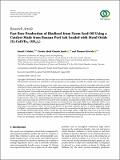| dc.description.abstract | Biodiesel is a possible remedy to the present toxic, finite sources and ever-diminishing crude fuels. Nonedible and locally available (Azadirachta indica) neem seed oil (NSO) as a second-generation feedstock was transformed into biodiesel using calcined banana ash (CBA) derived from banana peels blended with lithium calcium oxide iron (III) sulphate Li-CaO/Fe2 (SO4)3 catalyzed transesterification. Transesterification process was employed to minimize the free fatty acid (FFA) content of NSO to afford 99.8% yield under the condition of the reaction oil/methanol ratio 8 : 1, followed by addition of 1.7%wt calcined banana peels ash and 1.3%wt Li-CaO/Fe2(SO4)3 catalysts in 53 min, a notable time. It is important to note that the physicochemical properties of biodiesel in this study such as initial boiling points, flash point, pour point, cloud point, density, kinematic viscosity, final boiling points, and cetane index met ASTM D-6751 and EN 14214 standards. Decomposition profile of CBA was displayed by thermal gravimetric analysis (TGA), whereas in-depth analysis by scanning electron microscope (SEM), X-ray diffraction (XRD), X-ray fluorescence (X-RF), and Fourier-transform infrared spectroscopy (FT-IR) revealed that the high efficiency displayed by a catalyst from banana ash calcined at 650°C was due to the presence of potassium carbonate (K2CO3), a calcium magnesium silicate (CaMgSiO4), and potassium sodium sulphate (KNaSO4) contents that accounted for the high basicity of up to 11.09. Additionally, the nitrogen adsorption/desorption studies revealed that CBA interestingly exhibits a high BET surface area of 411.2 m2/g and promising mesopores (3.014 nm). The catalyst also displayed better recyclability evidenced by the fact that it was able to be reused after five successive runs with better recyclability of 75%. Based on the aforementioned properties, this work, therefore, opens an avenue for developing a supreme heterogeneous catalyst from available banana peels ash. | en_US |

